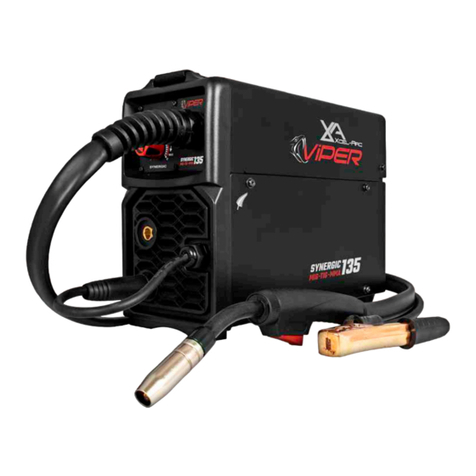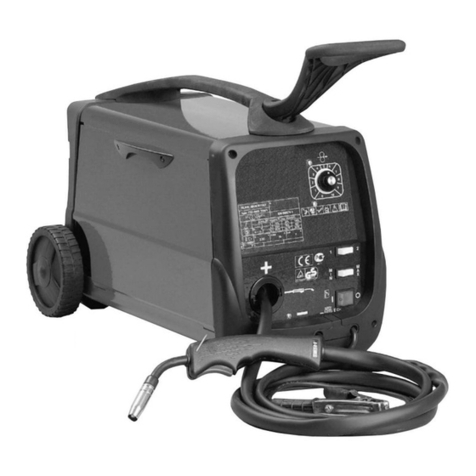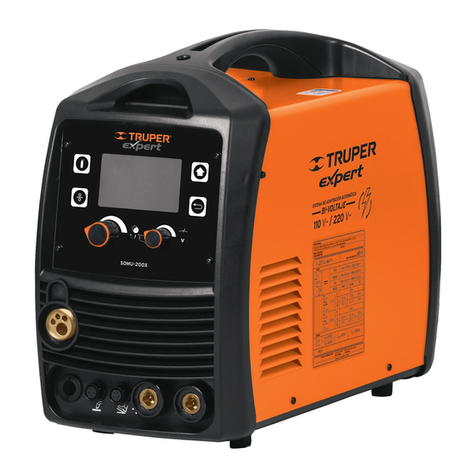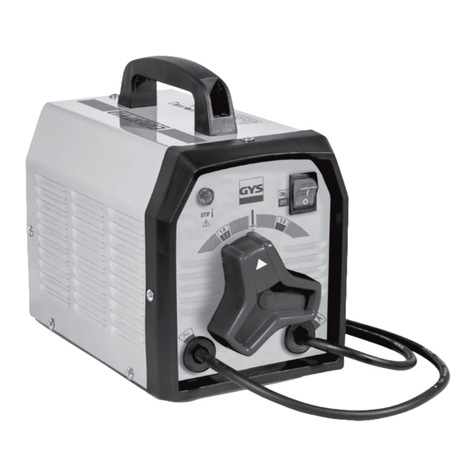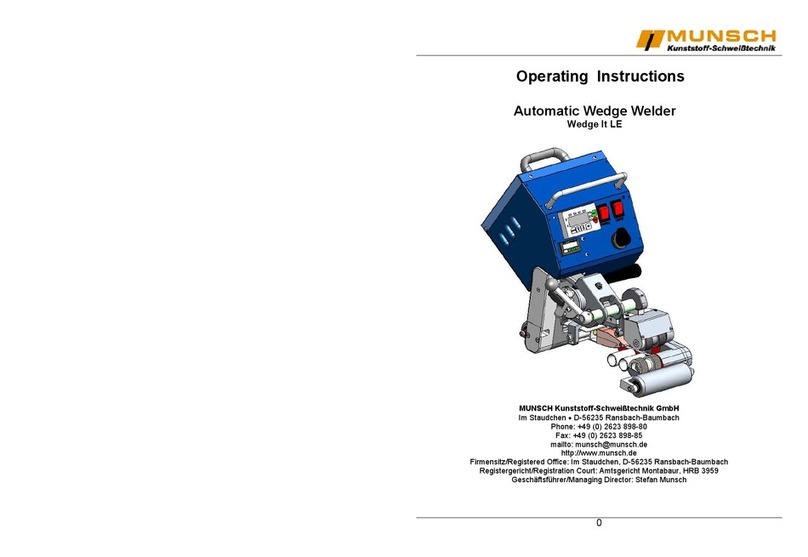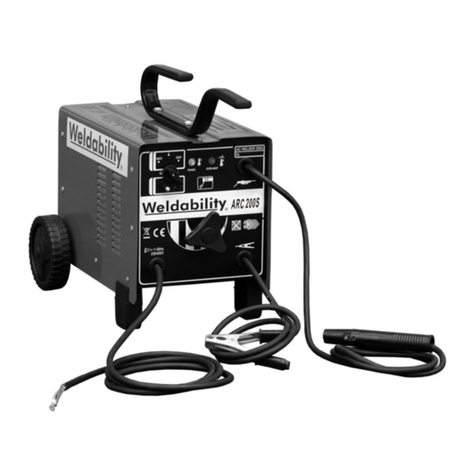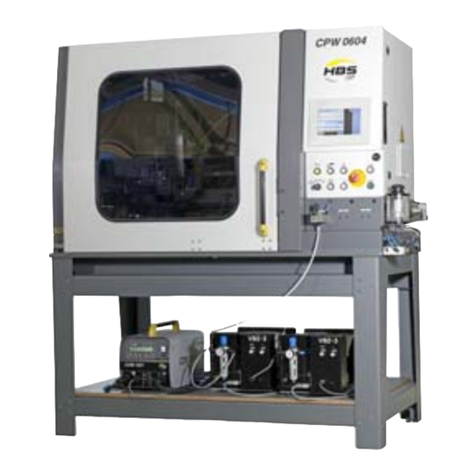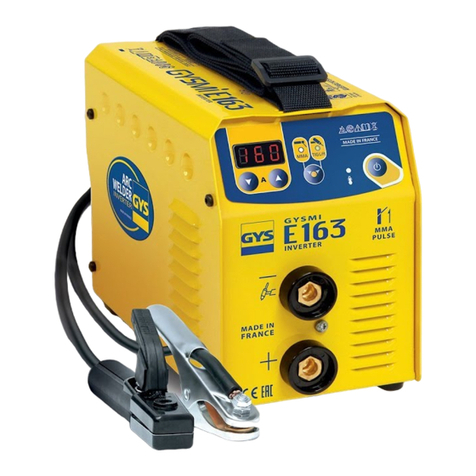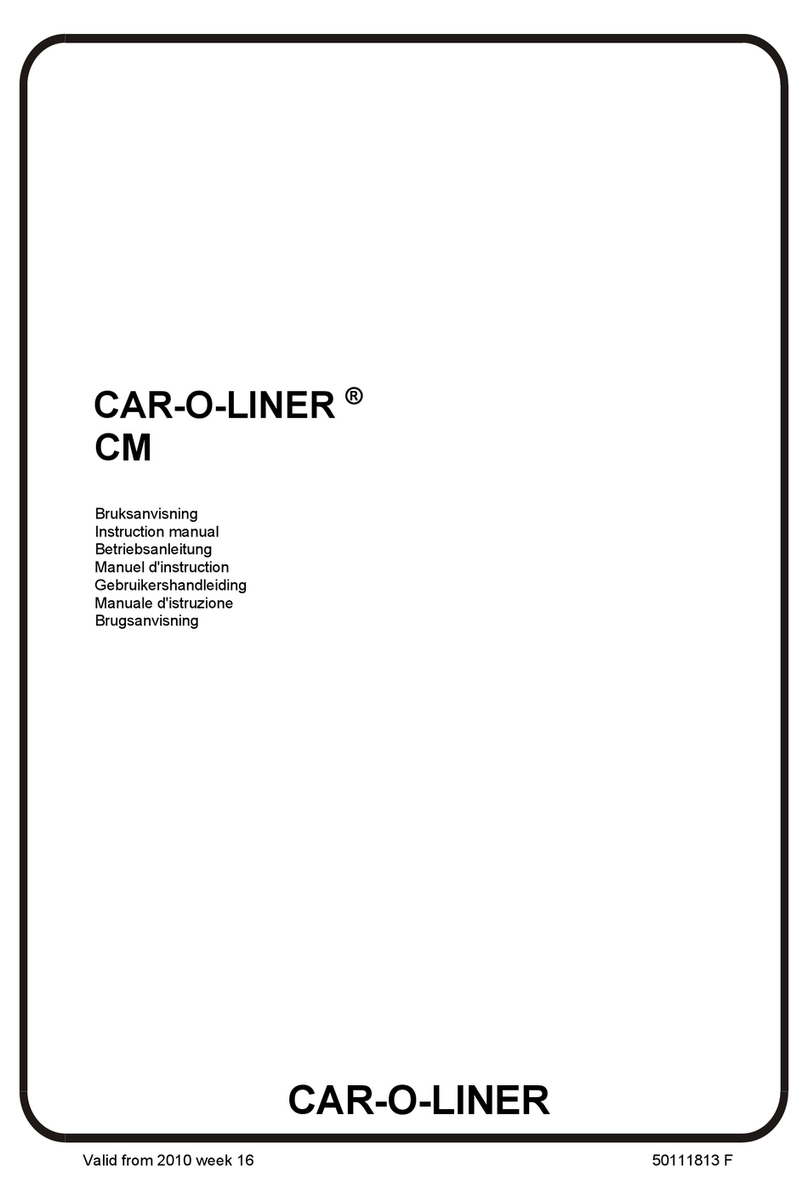GOODWIN P20 User manual

OPERATION MANUAL
for the
GOODWIN P20
AIR PLASMA CUTTING SYSTEM
P20 Instruction Manual Revision : 12 27th March 1998

The Company reserves the right to make such changes to the design or specification of the
equipment as it shall see fit. The information contained in this manual is issued for the guidance
of users and does not form part of any contract. It is strongly recommended that all users and
supervisors familiarise themselves with the contents...
PRIOR TO COMMENCING USE OF THE SYSTEM
...and in particular, the section on safety precautions which should be used as a guide to safe
operation in accordance with the requirements of the relevant Health and Safety at Work
legislation.
AIR PLASMA LIMITED
3 LIMEHURST AVE
LOUGHBOROUGH
LEICESTERSHIRE
LE11 1PE
ENGLAND
Tel No. ++(0) 01509 237369
Fax No. ++(0) 01509 234942
Email. [email protected]

Contents
1............................................................................................................................................... SAFETY 4
1.1 ............................................................................................................................................... General 4
1.2 ...................................................................................................................................Safety Features 5
1.3 ..................................................................................................................................... Warning Signs 5
1.4 .....................................................................................................Packaging Handling and Transport 5
2...................................................................... INTRODUCTION TO THE PLASMA PROCESS 6
3.............................................................................................................................. INSTALLATION 7
3.1 ......................................................................................................................................Power Supply 7
3.2 ............................................................................................................................ Earth Requirements 7
3.3 .......................................................................................................................... Phase Determination 8
4................................................................................... PLASMA AND TORCH CONNECTIONS 9
4.1 ..................................................... Connecting the Torch and Plasma Earth Lead to the Power Unit 9
4.2 ......................................................................................................................Control of Hand Torch 10
4.3 .................................................................................................................Control of Machine Torch 10
5 ....................................................................................................................................OPERATION 11
5.1 .............................................................................................................................. Machine Controls 11
5.1.2 ....................................................................................................................... Warning Indicators 13
5.2 ........................................................................................................................Power Up Procedure 14
5.3 .............................................................................................................................Cutting Procedure 15
5.3.1. ......................................................................................................... Starting and Finishing a Cut. 15
5.3.2, ................................................................................................................ Cutting With Stand Off. 15
5.3.3. ...............................................................................................................................Cutting Speed. 16
5.3.4. ............................................................................ Piercing Thicker Materials with a Hand Torch 17
5.3.5. .....................................................................................................Piercing with a Machine Torch 18
5.4 ................................................................................................................................. Troubleshooting 19
5.5. .............................................................................................................................Consumable Life. 19
5.5.1. ................................................................................................................................ Intrinsic Life. 19
5.5.2. .....................................................................................................................................Alignment. 19
5.5.3. ....................................................................................................................... Transient Damage. 19
5.5.4. ....................................................................................................................Operational Damage. 20
5.5.5. .............................................................................................................. Electrode “non-starting”. 20
5.6 .....................................................................................................................Changing Consumables 21
6........................................................................................................................TECHNICAL DATA 23
6.1 ....................................................................................................................................... Power Unit 23
6.1.1. ..............................................................................................................................Electrical Input 23
6.1.2. ........................................................................................................................... Electrical Output 23
6.2 .......................................................................................................................... Torch and Hose Set 23
6.2.1 .................................................................................................................................... Hand Torch 23
6.2.2 ...............................................................................................................................Machine Torch 23
7...........................................................................................................SERVICE INFORMATION 24
7.1 ................................................................................................................................ The Power Unit 24
7.1.1. ............................................................................................................................ Circuit Diagram 25
7.1.2. ................................................................................................................... Diagnostic Indicators. 26
7.2 ....................................................................................................... The Torch and Hose Set Repair 27
7.3 ..................................................................................................................................... Maintenance 28
8................................................................................................................................ Torch Blockage 29
8.1 ..................................................................................................................................Machine Torch 29
8.2 ......................................................................................................... Machine Torch exploded View 30
8.3 ....................................................................................................................................... Hand Torch 31
8.4 .............................................................................................................. Hand Torch exploded View 32
10. ......................................................................................................................................Fault Finding 33
10................................................................................................................................................ Index 34

1. SAFETY
1.1 General
Beforeany cuttingoperations are started,the usermustensure thattheinstallation andproposed
workingmethodscomplywithallrelevantsafetyregulations,environmentaland electricitystandards.
Theplasma arc producedat the torchheadis a jetof high energyandis potentially dangerous.
Usersunfamiliarwith aplasma arcshould seekbasic training.Goodwin AirPlasmacanoffercompre-
hensivetrainingcourses.
Inaddition,thefollowingpointsareparticularlyimportant:
a) Themainsconnectionmustbeproperly groundedand thesupplylinesfittedwith fusesof
thespecified rating.The mains cablemust beproperlysecured andprotectedfrom possible
damage.
b) Highvoltageexistsat the torch whenpower is applied andthepilot arc isstruck(up to
300V),and whenthe mainarcis cutting(150V). Underno circumstancesshouldanyone
touchthenozzlewith powerapplied tothe torch.Alladjustmentsandreplacement ofparts
shouldbe donewiththe powerunitsupply isolated.Thetorch should notbe used in
excessivelywet conditionsorif thetorchor hosesetare damaged inany way.
c) ThemainssupplyshouldbeisolatedfromtheunitATTHESUPPLY beforeremovingany
panelsfromthe unit.Onlyauthorised servicepersonnelshouldremovepanels.
d) Keeptheworkareaclearofallinflammablematerials.Ensurethatanymaterialejected
fromthecutisnotahazardto the operator or to others.
e) Protectionisnecessary againstultravioletradiation emittedfromthearc.A helmetor
shieldwithshadeglass isrecommended. Weargloves andadequate protectiveclothing
whereappropriate. Adequatescreening shouldbearranged toprotect othersin thevicinity or
passingbyin asimilar mannerto thatrequired forarc weldingoperations.
f) Adequateventilationorfumeextractionto removethe cuttingfume anddust isrequiredat
alltimesaround anyplasmacutting operation.Whencuttingflatsheet, ashallowwater
bedcuttingtable willgreatly reducethefumesanddust whichmainlyoccurbelowthe cut.
g) Thewheelson theunitare meantforease ofmovementaround the workplace and should
notbe used over rough surfaces nor atexcessivespeeds.
h) Theplasmapower unitshould bepositioned onstable levelgroundandifnecessary
securedagainstanyunwanted movement.
i) The operationof thisequipmentandtheplasmacuttingprocess canresult innoise levels
thatcouldbeharmful,Theemployershouldundertakeanoiseassessmenttomonitor
compliancewithrelevantlegislation.
j) Materialto be cut shouldbe supported in sucha way that anymaterialcut from thework
piecewillnotbe ahazard andfall ontotheuser,theequipment,orothers inthe vicinity.
k) Careshouldbetaken when manoevering thehose set with eitherahand held torchorone
connectedto a robot arm or profiler,that it does not snag on objectsorother equipment
whichmay result in damagetothe hose set, ortopplethe objects or equipment.Hosesets
thatare subjectto excessivemechanicaltension mayresult indamage tothehose set
connectionsatthemachine orthe hoseset componentsthemselves.

1.2 Safety Features
Theplasmaunit includesthefollowing featuresforthesafetyof theoperator:
* Thebody of the plasmatorchis earthed.
* Thecontinuity ofthe torchearthand thevoltage onthe bodyismonitored.
* Cuttingcurrentflowinginthesupplyearthismonitored.
* Thevoltageon thetorch nozzleismonitored.
* Intheeventof afaulty conditionof theabove,themachinewill switchoff powerto the
torch.
Theemergency stopprocedure is toturn themainisolator totheoff position,which is locatedon the
lowerfrontcontrol panel.
Atool (flat bladedscrewdriver) is requiredtoremove the canopy foraccess to the internalcompo-
nents.Underno circumstancesshould thecanopy beremoved whilstthe mainssupplyisstillconnected.
Onlysuitablytrained andauthorised personnelshouldremovethecanopy.
1.4 Packaging Handling and Transport
Shouldthe plasmaunitneed tobeshipped, werecommendre-use of theoriginal packing crate.Also:-
a)That the hose set be disconnected to prevent any damage to thehoseset/plasma connections.
b)That thecontrol panel isadequately protectedagainstpotential damage.
c)Anyliftingshouldbedoneusingtheeyeboltlocatedinthetopofthecanopy togetherwith certified
liftingequipment(notsupplied). Precautionsshould betaken topreventrotationaboutthe eyebolt.
d)Theplasmaunit shouldbe shippedand storedintheuprightposition toavoid anyheavy internal
componentsbreakingfreefromtheirmountings.
e)Storage shouldbe undercover,preferably inaclean dryenvironment.
1.3 Warning Signs
Thelocationof thewarningsigns fittedtotheplasma
unitare:
a) Atthefront ofthemachine -
WarningOpenCircuitVoltage300volts.
b) Ateach rear lower corner of the canopy -
WarningDisconnectthe MainsSupply.....
Theseshouldbemaintainedinalegiblecondition.

2. INTRODUCTION TO THE PLASMA PROCESS
Theplasma process iscreatedby passing astreamof clean ionised air,provided by anoil free
compressor,through aNOZZLE in thetorch.The air streamis ionised byaPILOT ARC, initiatedbya
HIGHFREQUENCYunit(HF Unit)which passesfrom theELECTRODEtothenozzle whenthe
torchis activated. When the PILOTARCis brought close to the workpiece,MAIN ARC is
TRANSFERREDtotheworkpieceasajetofhighenergywhichrapidlymeltsanymetal withwhich it
makescontact,providing fastcutting,low residualheatinput,andlow materialdistortion.
Theelectrode and nozzle are cooled by air (and water in water cooledtorches),andasthe air is passed
throughthe nozzle itis caused toswirlaround the arcby a SWIRLBUSHto aid stabilityof the arc.
TheHF unit operatesautomaticallyto establish anarcwhen power is appliedto the torch andit ceases
tooperate when thepilot or mainarcis established.

3. INSTALLATION
Maybe carried out byacompetent electrician. No specialisttoolsare required.
3.1 Power Supply
Thepower unit isprovided witha length offlexiblecable which must beconnected to a 3 phaseand
earthelectricalsupply. Thesupply shouldbe fittedwithfuses orcircuit breakersof appropriaterating
andameansof isolatingthe powerunit fromthesupplyshouldbe provided.A plugshould befitted if
appropriate.Themachine isphase/rotation sensitive.
Referto the ratingplateon the machineandTechnicalData section6.1.1.for the correctvoltageand
currentrequirements.
3.2 Earth Requirements
Theinstallation shouldbe arranged suchthat theonlypath toearth(or ground)from the workpiece is
byway of theplasma earth leadconnectedto the frontof the machine.
Wherethe material tobe cut formspartof the structurewhich is earthedorgrounded to themains
electricalsupplysystem, thenthe cuttingcurrentcouldflowthrough thatrouteratherthanthe plasma
earthlead to themachine.Always ensure thatthereis a good connectionbetween the work pieceand
themachineviathe plasmaearth leadas apoorconnectionwillcause excessivecurrent inthe mains
supplyearthwhich willcreatea currenttripfaultcondition(see section7.4faultfinding).
Ininstallationswhereitisnotpossibletoavoidearthcurrenttrips,eventhoughagood cuttingcurrent
earthpath has beenensured, it willbenecessary to checkthat the alternativemainsearth paths are
substantialenoughto carryhigher currentsthanthecurrenttrip settingof10ampswithout causing
damage,as where thecutting earth isnotconnected to thework piece atall,this would bethe full
cuttingcurrent. If theearthpaths are notsubstantialthey must be upratedor re-routed to avoidthe
possibilityof damage. Oncethe necessary checksandprecautions have beentaken, the earthcurrent
tripcircuit maybe disabled bymeans oftheswitch ontheEarth CurrentRelay (ECR) locatedinside the
powerunit.

3.3 Phase Determination
Connectthe torch to themachine(see section 4).
Fillthewatersystemwithdistilledwater.
Note. Toavoid damagingthe waterpump themachine shouldnot berun withoutwater inthe
system,also, the machineshould not berunfor more thana few secondswithouta torch connectedto
themachine.
Switchonthe machineby rotatingthe mainisolator andpressing theon/offbuttonensuringtheaccess
dooris closedandthe emergencystopswitch isunlatched.
Correctphaseconnection isdetermined bycheckingthatthecooling airflowingthroughthepower unit
isfromtheleft handpaneltotherightofthemachine.Also,the waterlightwillbeilluminatedifthe
motorsare rotating incorrectly. Iftheseconditions are notcorrect, change twoofthe three phase
connectionsat thepowersupply andcheckagain.
If there is any doubt regarding installation, consult your distributor or Goodwin Air
Plasma.

4. PLASMA AND TORCH CONNECTIONS
4.1 Connecting the Torch and Plasma Earth Lead to the
Power Unit
Note. Donot runthepower unitwithoutthe torchconnected.
Theconnections to the powerunitare located behind theaccessdoor at the frontofthe unit. The torch
hoseset must pass through theaperturebelow the door beforemakingthe connections. Care mustbe
takento obtaingoodconnections.
Torchconnectionto the power unit ismade by a composite hoseset.
Watersupplyline - Bluehosewithshortpushinconnector.
Waterreturnline - Bluehosewith longpush inconnector.
Airand Powerline - Blackhose andorange cablewithscrew fitting.
PilotArc/Torchearthline- BlackCo-axial cable withplug andscrew collar.
Pilotearth/controlline - White3 Core cable with 3 pole plug.
Theplasma earth leadis connected viathepush in andtwist clockwise socket.
Note. Theaccess door is interlockedwiththe control circuit henceneedsto be shut beforethe
powerunitwill operate.
Thewaterfittingscannotbefittedincorrectlyalthoughthereturnline(long)willfitinthesupplyoutlet
(short)for back flushing thetorch.Toremove thewaterhoses, push the waterconnectorcollars to
release(both together to avoid lossofwater).
Whenfirstswitchingon,allowenoughtimeforthewatertocirculatethroughthesystem.Topupthe
radiatoras required. Useonlydistilled or de-ionisedwater. (See section 7.1regardinguse of methanol
infreezingconditions).
DIAGRAM TO SHOW HOSE SET CONNECTIONS
EARTH
CONNECTION
HOSESET
ACCESS
DOOR

4.3 Control of Machine Torch
Ifthemachinetorch isused, plugthe remotecontrol(optionalextra)plug intothe remotecontrol
socket.
Ifthemachine isto beinterfaced toa profilingmachine, robotorotherautomaticsystem,thefollowing
remotecontrol socket connectionsmay be used.
Pilotarc relay contactscan also beprovidedwhen necessary. If indoubtcontact Goodwin AirPlasma
foradviceon interfacingtoother equipment.
REMOTECONTROL
SOCKET
12voltsupply
Earth
ArcTransfer
signal
PlasmaOn
plasmaon
contacts
(12V dc
100mA)
pin 1
2
3
4
Plasma
On
4.2 Control of Hand Torch
Thehand torch isprovidedwith a presson/ release off controlswitch on the handlefor operation of the
plasmaarc.
Note. Coolingairwillflowthroughthetorchatalltimeswhenthemachineisswitchedon.
Ifa handtorch istobe usedin conjunctionwith amechanicalmanipulator ortractor unitetc.,when the
operationof thehandle mountedpresson /release offcontrol switchwillnot bepossible, plugthe
remotecontrol (optionalextra) switchunitinto theremote controlsocket asforthe machinetorch.
Diagram to show Automatic Machine Interface.
+12volts onmain arc transfer
(switchedtoground)
12VOLT
RELAY

5 OPERATION
5.1 Machine Controls
Thefront panel ofthe machine providesarange of displaysand control geartoensure correct operation
VOLTMETER
EMERGENCYSTOP
WARNING
INDICATORS
ON/OFFBUTTONS
MAINISOLATOR
OUTPUTONLAMP
AMPMETER
AIRPRESSUREGAUGE
POWERCONTROL
SWITCH
AIRREGULATOR
ACCESSDOOR
HOSESET
ON / OFF BUTTONS
Switchesauxiliarycircuits onand off.ieCompressor,waterpump,cooling fanand controlcircuits
MAINISOLATOR
Isolatesmachinefrommains supply. Itmay bepadlockedin theoffposition.
EMERGENCYSTOP
Switchesmachineoff.Theswitchlatchesmechanicallyandmustberotatedtorelease.
DOOR INTERLOCK
Ifthe access door isopenthe machine will notwork.
HOSE CONNECTIONS
Seesection 4. Connectiong thetorchto the power unit.

VOLTMETER
Indicatesthe arcvoltage.
Typicalvalueswouldbe: Power applied to torch butno arc 300v
ForPilot Arc 250 to 280 volts
ForMain Arc 120 to 180 volts
AMPMETER
Indicatesthe arc current.
Typicalvalueswouldbe: Power switch set to 5kw 50 amp
10kw 90 amp
15kw 120amp
20kw 150amp
OUTPUTONLAMP
Indicatesthat power is applied tothetorch.
AIRPRESSUREGAUGE
Displaysthe backpressure inthesystem duringthe pilotarc andcuttingmodes
Typicalvalueswouldbe: ForPilotArc 0.7 to 1.4 bar (10 to 20 psi)
ForMain Arc 2.4 to 3.4 bar (35 to 50 psi)
AIRREGULATOR
Setsthe air flowthroughthe torch to giveastable pilot arc.

WATER
EARTHSAFETY
TEMPERATURE
EARTHCURRENT
POWER
PILOTTRIP
POWER INDICATOR -
Indicatesthatpoweris availableto thesystem controlcircuit.
TEMPERATUREINDICATOR-
Indicatesthattherectifierortransformertemperatureistoohigh.
WATERINDICATOR-
Indicatesinsufficientwaterflowinthetorch.
EARTH CURRENT INDICATOR-
Indicatesexcessive currentsin the supplyearth (seesection3.2).
EARTH SAFETY INDICATOR-
Indicatesa break in theearthconnection to the torchora voltage in excessof10 volts to thetorchbody.
PILOT TRIP INDICATOR -
Indicatesthepilot archas excessivecurrent, dueto consumablecondition orinsufficientair flow.
5.1.2 WarningIndicators
Seesection 7.1.2 Displays andControlsfor more details.

5.2 Power Up Procedure
Havingcompletedthemains andcutting earthwiring, connectedthetorchandchecked thefan rotation,
themachine isready foruse.
Switchthe machineon andafterallowing timefor thewater tocirculatethrough thetorch, pressthe
waterreset button onthefront panel. Theredindicators should go out.
Toascertain the absenceof air leaks,theair regulator shouldbe wound fullyclockwiseand the pressure
gaugeshould indicate a back pressure in excessof1.6bar.
Itis nownecessaryto adjusttheair pressuretogive the highestpossible reading consistentwith good
arcstarting and astable pilot arc,thisshould around 0.9bar.Switch onthetorch with thenozzle well
clearof any workpiece, person orequipment,and re-adjust theair pressure untilitis at maximumor
thepilotarcbecomesunstable(verynoisy,misfire, andthe voltmetershowing 300volts). Atthis point
reducethe pressure to restorestability(arc less noisy, stable arc, andthevolt meter showing 250/280
volts).
Alwaysmaintainashigh anair pressureas possibleforpilotarcas thisgives thebest consumablelife.
Theoutput lamp is “on” and the voltmeterreadsbetween250 vdc and 280 vdc at thisstage.
NOTE.
Asplasma powerunits donothave avoltage stablisedpower supply, afluctuation intheinput voltage
willdirectlyaffect theoutputcurrent. Thismaynotbenoticeable iftheinputvoltagerisesslightlyabove
thenormas itwill providemore powerfor cutting.If theriseisexcessive,consumablelifemay suffer.
However,whentheinputvoltage falls,the outputpower alsofalls, affectingboth thepilot arcand main
arc.In these circumstancesit will benecessaryto adjust theair pressure regulatortoreduce the airflow
toobtain a stablepilot arc, andreadjustit when themains voltage returnstonormal.

IMPORTANT
Ifthe arcshould “flare”,becoloured green,or emitany unusualnoise,it isrecommended thattheunit be
immediatelyswitchedoffand thecondition ofthe consumableschecked.Cuttingunderthese conditions
mayresult indamage extending beyondthe consumablestoother partsofthe torch.
Undernormalcutting conditionsthe torchisdesignedto
operate with a STAND OFF of about 6 mm (except P50
8mm). Thisis the distancebetween theendof thenozzle
andtheworkpiece.
Wherethe work pieceisrusty,scaly, or with thick
sectionsof steelor aluminium etc.,a buildupof drosson
thetop of thework piece mayoccurwhich will cause
damageto thenozzle. In theseconditions, thestandoff
distanceshouldbeincreased slightly.
Aguide ringis avalabletoassist theoperator in
maintainingthedesired standoffheight. Thiscanalsobe
usedagainstastraight edgeto maintaina straightcut.
5.3.2.CuttingWithStand Off.
5.3 Cutting
Procedure
Wherepossibleitisbettertostarta cut at a plate edge or hole because the piercing process reduces
consumablelife.
Cutscan bestarted byeitherinitiating thepilot arcand movingthetorch intothe proximityofthe work
piece,or by positioning thetorchover the edge ofthework piece and startingthepilot arc.
Materialswith a capacityto absorb heatenergy,especially thickersections,require more careand
techniquewhen starting acut.In these casesthecut will appear slowto start and piercethrough the
material.Once acutis establishedthencutting speedsmaybe increased.
Cuttingcan be stopped eitherbyreleasing the torch switch,switchingoffthe power, orbywithdrawing
fromthe workpiece (bestdone rapidly).
5.3.1.StartingandFinishingaCut.

5.3.3.Cutting Speed.
Bestresultsare usuallyobtained bycuttingattheoptimum cuttingspeed.
OPTIMUMCUTTING SPEED
Correctcutting speedis judged byexperience from
observingtheangle atwhichthe cutmaterialleavesthe
loweredge of theplate, either byobservingthe ejected
materialor bystudying thesurfaceof acut aftercomplet-
inga test cut. The dragbackof the arc is aproximately 30
degrees.
CUTTING TOO SLOW
Arcappearstoblow straightthrough thematerial.
Excessivedrossmayaccumulateontheundersideofthe
material.
CUTTING TOO FAST
Arcfails topierce thematerial.Blow backof drosswill
damagethenozzle.
MAXIMUMCUTTING SPEED
Dragback of thearc is around45°,but cut qualitywill
deteriorate.

5.3.4.PiercingThicker Materialswith aHandTorch
Piercingwillcausecut materialtobeejectedupwardswhichcanbedangerous,and hasariskofdamaging
the torch nozzle. This problem is worsened as material thickness increases because it takes longer to
pierce.Ifit isnecessaryto pierce,thenitisbest donebyanglingthetorchandgraduallybringing itupright
aspiercingis completed.
Initiatethe pilotarcand laythetorch overatapproximately 60º
Begintwistingthetorchslowlytowardsaverticalpositiontaking
caretoavoid ejectedmaterial fromhitting thenozzle. Atthe
sametime, thetorch shouldbemoved asmall distancealong the
workpiece.
Aspiercing completes,the nozzlecanbe broughtto verticaland
cuttingcancontinue.
Ifthe torch is pivoted about the nozzle there is a risk of material
beingblownback ontothe nozzlewhich willcause damageto the
nozzleorevento thetorch itself.
*
Imaginarypivotpoint.X
X
X
X
X

5.3.5.PiercingwithaMachineTorch
Whenusinga machinetorch, itis notgenerally possibleto anglethetorchforpiercing.
Startthe pilotarc abovethework piece,and withthe torchtravellingat abouthalf ofthenormal cutting
speed,lower thetorch until mainarc transferoccurs.
Oncepiercing iscomplete, the torchmay bebroughtto normalstandoff andcutting speed.
GoodwinAirPlasma offeran AutomaticHeight ControlUnitasanoptional extrafor machinetorches
integratedwithprofiling machinesorrobot arms.Askyourdistributoror GoodwinAirPlasmafor
furtherdetails.
STAND
OFF
20MM
15MM
10MM
NORMAL
ê
è
Positionthe torch around 20mm from the work
piece, start the pilot arc and torch manipulator
movingathalfspeed.
Lowerthetorch untilmain arctransfers.
At this point, the descent speed of the torch is
important.Ifitistoofast,theejectedmoltenmetal
willdamagethetorch.
Continue to lower the torch slowly after arc
transferuntil the nozzle is 10mm from thework
piece.
Waituntilthearchascompletedpiercingthrough,
thenlowerthe torchand maintaina normalstand
off for the duration of the cut. Cutting can now
continueatthefullrecomendedspeed.
è
èè
ê
ê
è

Bevelis more noticeableon thinner sectionsandis more pronouncedon the lefthandside of acut. It is
dueto theclockwise swirlingofthe airinduced bythe swirlbushin theelectrode assembly. Beveledges
canbe desirableas an aidto weldpreparation,however itcanbe virtuallyeliminated by reducingthe
cuttingspeed butat the expenseof accumulateddross.For minimumbevelcut clockwisearound a
componentandanticlockwise ina hole.
5.5.Consumable Life.
Agoodconsumablelifeisthesinglemostimportantfactor inachievingoptimumcuttingeconomicsof
anyplasmacuttingunit.Thislifeisdependentontheintrinsiclifeoftheconsumables,correctalignment
andtheincidenceof transientand operationaldamage.
5.5.1.IntrinsicLife.
Theintrinsic lifeofthe consumablesisdetermined bytherate at whichthey are erodedby the arc
process.This erosionrateis howeverlow,and in practice,the life islimited by otherfactors. The insert
inthecentrewillbeerodedslightlyeachtimethearcisstruckeventuallycreatinga visiblecrater.The
cratercanbemorethan2mmdeepbefore the electrode is considered to be expired.
5.5.2.Alignment.
Thealignmentand constructionof theGoodwinAirPlasmaTorch issuchthatproblemsof grindingand
adjustingelectrodesdo notoccur.Withreasonablecaretakeninfitting theconsumables, alignment
problemsshouldnotarise.
5.5.3.TransientDamage.
Onstarting directly ontomain arc, itisoccasionally possible toerode some ofthecopper from the
electrodebefore the arc settlesontothe insert material. Thisgeneratesa crater in theelectrodeand the
insertburns backto becomeflush.Consumable lifeis thusreduced ifthereis ahigh numberofstarts
relativetothetotalcuttingtime.
Cuttingspeedtooslow.Torchconsumableswornordamaged.Insufficient
airflow.
Damaged torch consumables. Nozzle blocked by dross or too close to
workpiece.Insufficientairflow.
Nozzle orifice damaged. Electrode eroded “off centre”. Consumables
wronglyfitted.
Speedtoohigh.Standofftoohigh.Arcnotstraight-consumablesdamaged
ormisaligned.
Excessivedross onlower
edgeof cut.
Doublearcing.
Mainarcnotsquare to
workpiece.
Excessivebevelorrounded
cutsurface.
5.4
Troubleshooting

5.5.4.OperationalDamage.
Thisisthemostlikelycauseoflimitedconsumablelife.Sincethearcisquitecapable ofcutting copper,
anythingwhichcausesthearctodeviatefromthecentreofthenozzlewillresultin damageto theorifice.
Inextreme cases thearcpasses not throughtheorifice but from theelectrode to the nozzleand from the
nozzleto the workpiece- DOUBLEARCING,causing therapiderosion of copperfromboth
electrodeandnozzle.
Themostcommon causeof theseproblems isfrom ejectedcut materialenteringtheorificeparticularly
whenpiercingor obstructingthe nozzlewith thework piece.
Itisbestto operatewithin themaximum speedcapabilitiesofthemachine andavoid unnecessary
piercingorstop-startcuttingwheneverpossible.
5.5.5.Electrode“non-starting”.
Occasionally,it mayhappen thatit isdifficultto startthe pilotarc. Thishappens whentheoxidized
materialfrom the electrodeinsertis deposited overthesurface of the copperelectrode and inside the
nozzle.Starting canbe improvedbycleaning orscratching thesurface oftheelectrode witha wirebrush
orsharpimplement.Alwaysswitchoffthepower unitbefore removingthe nozzlefor thispurpose. Once
a“non-starting”electrodehasbeenusedafewtimes,startingusuallyimproves.
Itisnot goodpractice tofire thepilot arccontinually inmidairwithoutstrikingthecuttingarc asthis
oxidizesthe surfaceof theelectrodeand leadsto “non-starting”problems.
Sincecutting usuallyimprovesa non-startingelectrode,it maybedesirable to usea piece ofscrap
materialandstart themainarc immediatlybypositioningthetorch closetothematerialbeforeswitching
on.Once started, continuetocut for aslongas possible before tryingto re-initiate the pilotarc.
ILLUSTRATIONTO SHOWELECTRODE DAMAGE
NEWELECTRODE USEDELECTRODE WORN OUT EXPIRED
Table of contents
Other GOODWIN Welding System manuals
Popular Welding System manuals by other brands
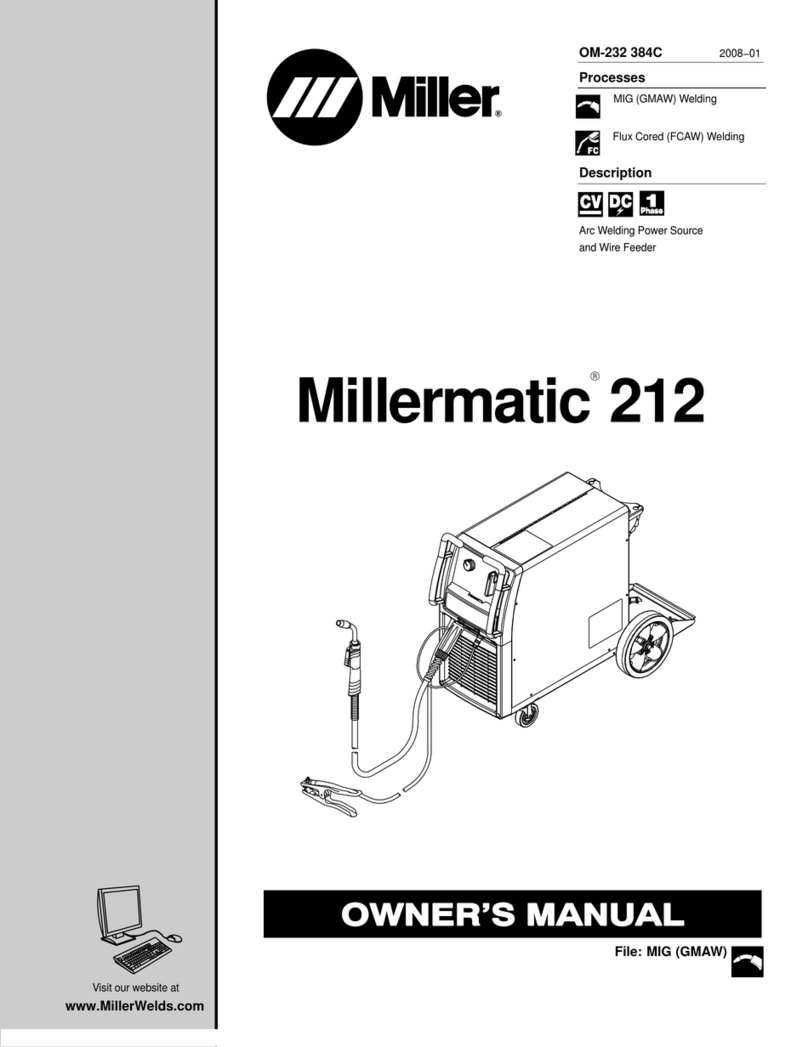
Miller Electric
Miller Electric Millermatic 212 owner's manual
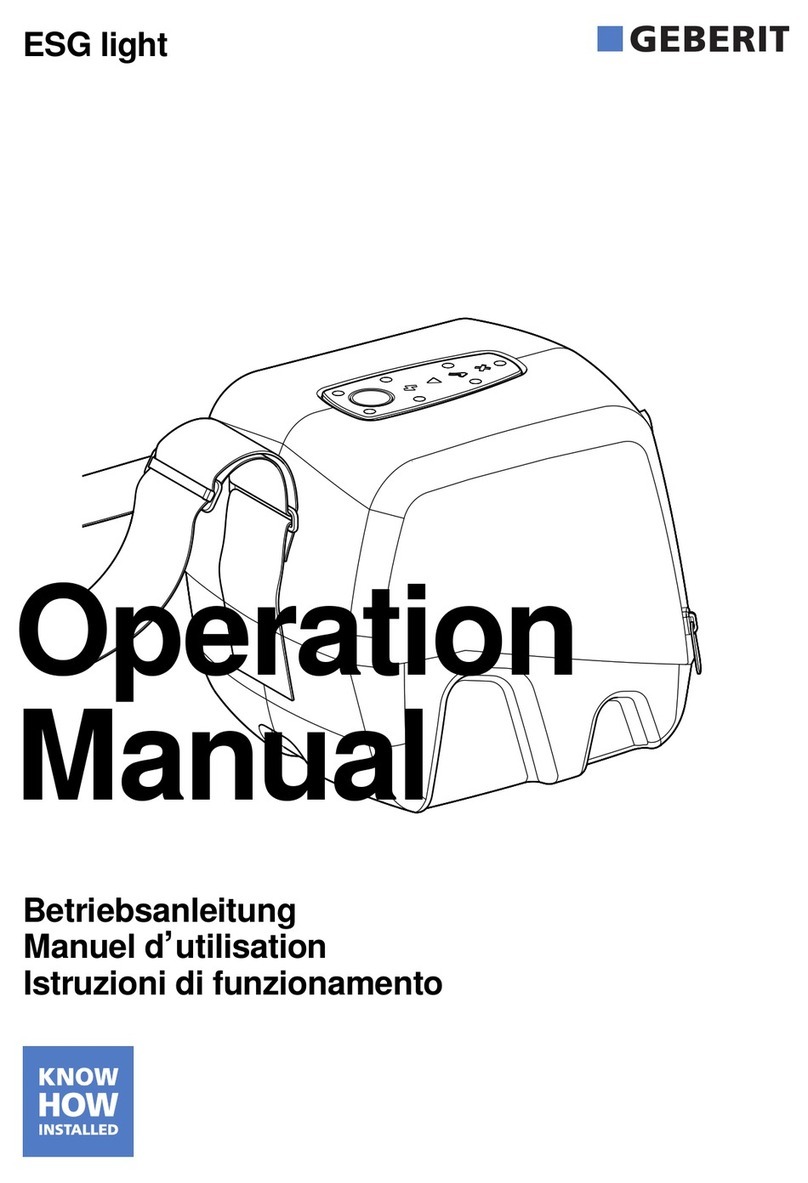
Geberit
Geberit ESG light Operation manual

Lincoln Electric
Lincoln Electric POWER WAVE 11124 Operator's manual
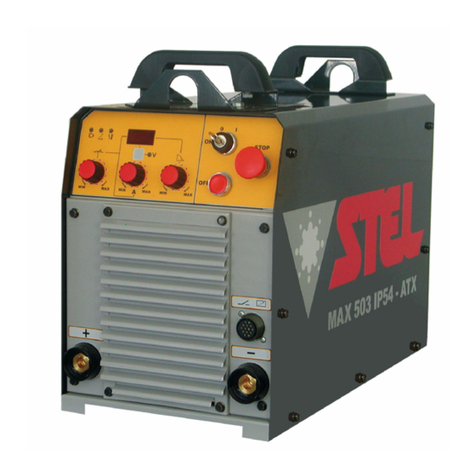
Stel
Stel MAX 503 IP54-ATX Instructions for use and maintenance
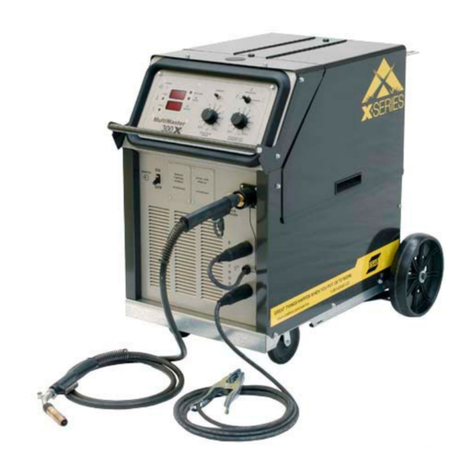
ESAB
ESAB Multimaster 300 instruction manual
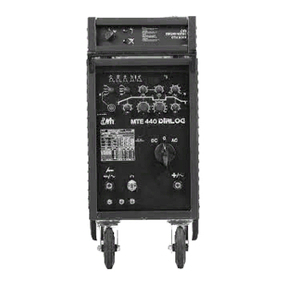
Migatronic
Migatronic MTE DIALOG instruction manual


